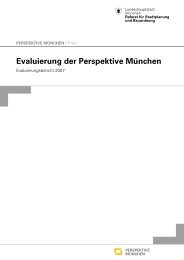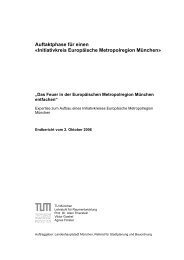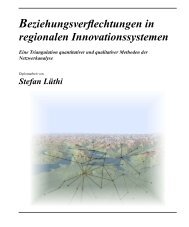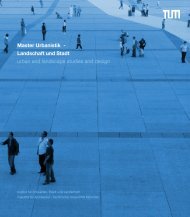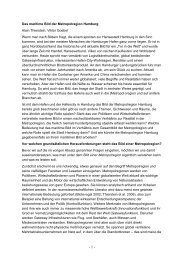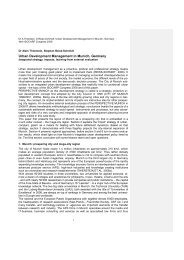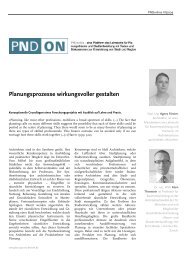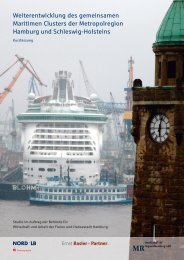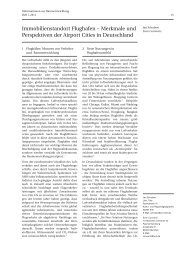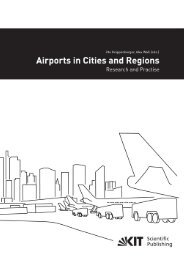0.6-1-Cover and Table of Contents-pp 0-05.indd - Raumentwicklung ...
0.6-1-Cover and Table of Contents-pp 0-05.indd - Raumentwicklung ...
0.6-1-Cover and Table of Contents-pp 0-05.indd - Raumentwicklung ...
Create successful ePaper yourself
Turn your PDF publications into a flip-book with our unique Google optimized e-Paper software.
The Role <strong>of</strong> the Design Studio in Shaping an Architectural Education for Sustainable Development:<br />
The Case <strong>of</strong> Beirut Arab University<br />
KHALID S. AL-HAGLA<br />
the issue under study, pilot study questionnaire,<br />
<strong>and</strong> the final developed questionnaire. In<br />
addition, the study incorporates two methods<br />
<strong>of</strong> data collection: document analysis <strong>and</strong> a<br />
questionnaire survey, which were designed<br />
to generate both statistical quantitative <strong>and</strong><br />
qualitative data, this would yield explanations<br />
concerning the o<strong>pp</strong>ortunities for <strong>and</strong> barriers to<br />
embedding ESD in the design studio. Specific<br />
respondents’ comments were selected from<br />
the questionnaire sheets, which either illustrated<br />
a generally representative view or <strong>of</strong>fered<br />
particularly interesting explanations (Jones et<br />
al., 2008:343).<br />
Questionnaire<br />
The questionnaire was designed to identify how<br />
educators perceive education for sustainable<br />
development as incorporated into studiobased<br />
architectural design education. The<br />
questions are focused mainly on the curriculum,<br />
the external <strong>and</strong> internal aspects, <strong>and</strong> the<br />
evaluation process. Questions were based<br />
on literature in the areas <strong>of</strong> ESD, architectural<br />
education, validation <strong>and</strong> accreditation,<br />
survey methods, <strong>and</strong> a pre-test survey. The<br />
questionnaire included only closed-ended<br />
questions with a comment area at the end<br />
(Milburn <strong>and</strong> Brown, 2003: 47-48). A rating system<br />
was developed based on a Likert-scale from 1<br />
to 5, in which 5 is excellent. The sample included<br />
male <strong>and</strong> female students <strong>and</strong> encompassed<br />
the last three levels in the architectural design<br />
studio (third, fourth, <strong>and</strong> fifth level students) The<br />
responses were analyzed using a framework<br />
a<strong>pp</strong>roach (Ritchie & Spencer, 1994), which<br />
involved a process <strong>of</strong> systematically coding <strong>and</strong><br />
grouping data to provide a coherent thematic<br />
framework (Jones et al., 2008:344) to group<br />
comments reflecting similar attitudes.<br />
Education for sustainable development (ESD) in<br />
higher education<br />
The most, as widely acknowledged by literature,<br />
accepted rational for incorporating sustainable<br />
development in education is given in Agenda<br />
21 at the UN Conference on Environment <strong>and</strong><br />
Development - UNCED (Earth Summit, 1992)<br />
(Warren, 2004:104). This 40-chapter agreement,<br />
in its 36th chapter addresses that “Education is<br />
critical for promoting sustainable development<br />
<strong>and</strong> improving the capacity <strong>of</strong> the people<br />
to address environment <strong>and</strong> development<br />
issues. Despite, basic education provides<br />
the underpinning <strong>of</strong> any environmental <strong>and</strong><br />
development education, the latter needs to be<br />
incorporated as an essential part <strong>of</strong> learning”<br />
(cited in Blewitt, 2002, p3). After about a decade<br />
<strong>of</strong> this agreement, the UN declared 2005 till<br />
2014 as a Decade <strong>of</strong> Education for Sustainable<br />
Development.<br />
Among the three sustainability dimensions<br />
(environmental, social, <strong>and</strong> economic), it is<br />
<strong>of</strong>ten the environmental angle that comes to<br />
the fore in ESD (Brunton, 2006:38). ‘Greening<br />
the university’ or ‘greening the curriculum’ have<br />
become commonly used phrases that tend<br />
to refer to the integration <strong>of</strong> environmental<br />
perspectives into university operations <strong>and</strong><br />
teaching (Alabaster <strong>and</strong> Blair 1996). This is rooted<br />
in the analogy between the developments<br />
<strong>of</strong> environmental <strong>and</strong> ecological education<br />
<strong>and</strong> the underst<strong>and</strong>ing <strong>of</strong> sustainability. While<br />
the field <strong>of</strong> ecology shifted from a problemsolving<br />
focus to a systems a<strong>pp</strong>roach stressing<br />
connectivity <strong>and</strong> relationships between<br />
organisms <strong>and</strong> communities (Capra, 1996),<br />
the epistemology <strong>of</strong> sustainable development<br />
literacy builds upon this shift with the addition <strong>of</strong><br />
an emphasis on the interrelationship between<br />
Archnet-IJAR, International Journal <strong>of</strong> Architectural Research - Volume 6 - Issue 1 - March 2012<br />
25



